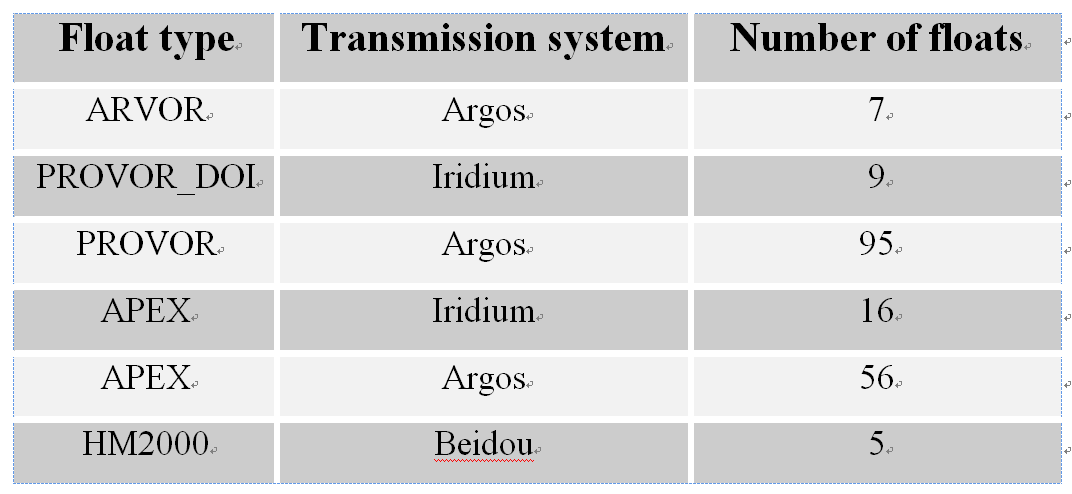Chinese Argo National Data Management Report ADMT-17
Editor :China Argo Real-time Time :2018-02-02 11:52:43 Visit :
Chinese Argo National Data Management Report
ADMT-17
Tianjin, China, 26-30 September 2016
1. Status
• Data acquired from floats
From October 2015 to September 2016, China acquired 5,833 profiles from 188 active floats including 113 active Argo equivalent floats (most are PROVOR floats). These floats were deployed by 7 PIs from 5 institutes in China. A statistic of different types of the floats is shown by Table1.
From the last ADMT meeting, CSIO started to submit profiles observed by HM2000 floats to GDAC. About 87 TS profiles (90-110 levels for each profile) from 5 HM2000 floats have been submitted.
This September, China will deploy 10 HM2000 floats (with cycle time about 5 days) in the South China Sea (SCS). It s the first time for China to deploy Argo profiling float in the SCS, and CSIO is ready to receive and process data for these floats. The design of the SCS regional Argo network will consist of 15-20 HM2000 floats.
NMDIS has operated 19 PROVOR floats since 2010. Till now, none of them is alive.
Table1 A statistic of different types of the active floats

From last October, CSIO started to send BUFR data on GTS through China Meteorological Administration (CMA), with bulletin header BABJ. However, we didn t send any corresponding TESACs under the same header. There was an interruption during April-May 2016 owing to a breakdown of FTP server at Meteorological Bureau of Zhejiang Province, from which the BUFR data are transferred to CMA.
CLS still helps us send BUFR data and TESAC messages on GTS except for the new deployed floats.
• Data issued to GDACs after real-time QC
From the last ADMT meeting, China submitted 5,833 R-files to GDACs after real-time QC. Among these profiles, 3,189 are observed by Argo equivalent floats, and 134 O2 profiles are obtained from 9 PROVOR_DOI floats.
This August, CSIO began to update all trajectory files. Now most of the trajectory files including files for HM2000 floats have been converted to V3.1. A new Matlab tool has been developed and used to create new netCDF trajectory file. It is very flexible because all the attributions for each variable are recorded in a table, the only thing an operator has to do is change the content in a table.
NMDIS has converted all the Argo data to V3.1 and submitted to GDAC after real-time QC.
• Data issued for delayed QC
Until now CSIO hasn t updated D-files from V2.0 to V3.1, and there is also a big backlog for DMQC including Argo equivalent floats. A new Matlab tool has been developed to convert old D-files into V3.1, but the new D-files have to be re-examined before submission.
NMDIS did not conduct DMQC since last ADMT meeting cause of the personnel adjustment and format changing.
• Delayed data sent to GDACs
It took a lot of manpower for CSIO to setup the BDS Profiling float Data Service Center (BDS-PDSC), as well as to update trajectory files, no D-files were submitted to GDACs this year.
None delayed data was submitted to GDACs by NMDIS.
• Web pages
Two web pages are maintained by NMDIS, and CSIO. The China Argo Data Centre (http://www.argo.gov.cn) and the China Argo Real-time Data Centre (http://www.argo.org.cn). Both sites provide the access to the float data, meta data, trajectory and their related plots. A new Argo web inquiry system is operating at CSIO (http://101.71.255.4:8080/flexArgo/out/argo.html), which provides global Argo data inquiry and downloading services.
• Statistics of Argo data usage ( operational models, scientific applications, number of National Pis… )
The Argo data have been used in scientific applications and operational oceanography at many institutions and universities. It has become the most important data source in studying about large-scale ocean variations. Several Argo products and reanalysis products have been developed, of which the BOA_Argo dataset is an annually updated monthly TS product from 2004. It has a horizontal resolution of 1o×1o, and 58 vertical levels between 0 and 1975 m.
2. Delayed Mode QC
(Please report on the progress made towards providing delayed mode Argo data, how it s organized and the difficulties encountered and estimate when you expect to be pre-operational .)
The number of China Argo equivalent floats is more than half of the Argo floats of China. It is the biggest challenge to complete DMQC for these floats. But DMQC will be restored as soon as BDS-PDSC becomes operational. The backlog is expected to be eliminated before the next ADMT meeting.
3. GDAC Functions
(If your centre operates a GDAC, report the progress made on the following tasks and if not yet complete, estimate when you expect them to be complete
None.
4. Regional Centre Functions
None.



 Your position :
Your position : 


